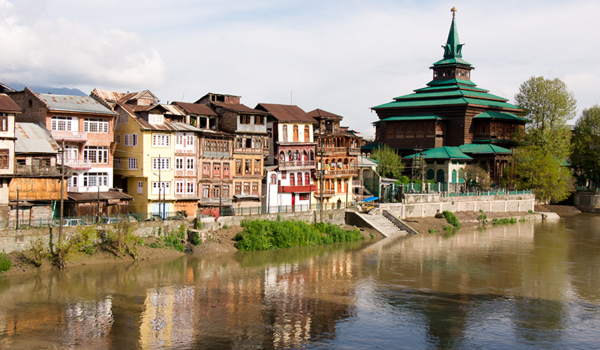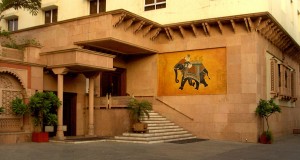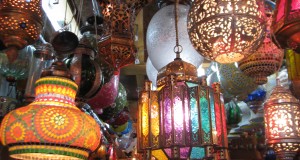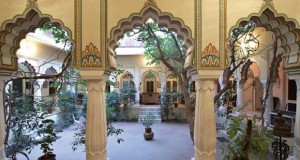Review Overview
Summary : The original mosque on this site dates back some 600 years; the new 1 building was created from voluntary subscriptions very recently.
Shah Hamdan-Jamia Masjid-Hari Parbat-Shankaracharya Temple- Hazratbal Mosque
Under present circumstances it is probably not possible to do this tour. But it’s included in the belief that the situation will improve. This is a pleasant cycle-excursion, best done on a Friday (Muslim holy day) when the town is a blaze of colourful, action-packed markets and bazaars. But it’s worth doing any day—just to explore Srinagar town and catch some of the local atmosphere.
Start from Dalgate, cycling down the Maulana Azad Road (the long avenue running past the Tourist Reception Centre) and over the Jhelum river. At the far slide , head right, keeping parallel to the river, and turn right again at the second bridge you come to.  This will bring you, in 15 minutes or so, to Shah Hamdan Mosque. This is one of the city’s oldest mosques and is dedicated to the 14th-century ‘apostle of Kashmir’, a Persian fakir called Shah Camden who was the best theologian and Sufi of his day and who did much to promote arts, crafts and learning. The mosque itself is remarkable for its papier mache work which adorns all walls and ceilings.
This will bring you, in 15 minutes or so, to Shah Hamdan Mosque. This is one of the city’s oldest mosques and is dedicated to the 14th-century ‘apostle of Kashmir’, a Persian fakir called Shah Camden who was the best theologian and Sufi of his day and who did much to promote arts, crafts and learning. The mosque itself is remarkable for its papier mache work which adorns all walls and ceilings.
Unless you are accompanied by a Muslim guide (your houseboat man is a good bet) you will only be allowed to admire the richly decorated external doorway. Inside, however, is some of the finest papier mache decoration in the world. Also beautiful carpets, chandeliers from Portugal, Spain and France, lacquered pillars, walls and balconies, and floral latticed staircases.
Continuing on, head right over two small bridges until the Jamia Masjid, the largest mosque in Kashmir, appears on your left (5 mins). Originally built by Sultan Sikandar in AD 1400, and enlarged by his son Zain-ul-Abidin, it was destroyed by fire on three separate occasions and was rebuilt each time. But its massive original pillars, made of solid beams of polished pinewood, were spared the flames. Today (remarkably) they look as good as new. The mosque can accommodate 10 000 orshippers and, on the last day of Ramadan each year, it does so. You can climb to e top of the unusual, square-shaped meenars for a fine view of the whole city. Outside the mosque, there’s often a lively bazaar in progress.
From the mosque, it’s a 10-minute ride right (then left) until Hari Parbat Fort comes to view. This is situated on top of Sharika Hill, an ancient Hindu holy site. The an around the hill was built, along with the almond orchards around it (beautiful In a spring), by Akbar in AD 1592-8. The fort atop it was an 18th-century addition, instructed by Atta Mohammad Khan, an Afghan Governor. Presently occupied by He Indian army, there is little to see inside except crumbling ruins. Permission to visit must be sought from the Director of Tourism.
Directly opposite the fort, on the other side of Dal Lake, you can see the gleamingbite Shankaracharya Temple. Situated at 1000 ft directly over Srinagar, it is believed to be one of the oldest Hindu shrines in the valley, and is dedicated to Shiva. previously known as Ta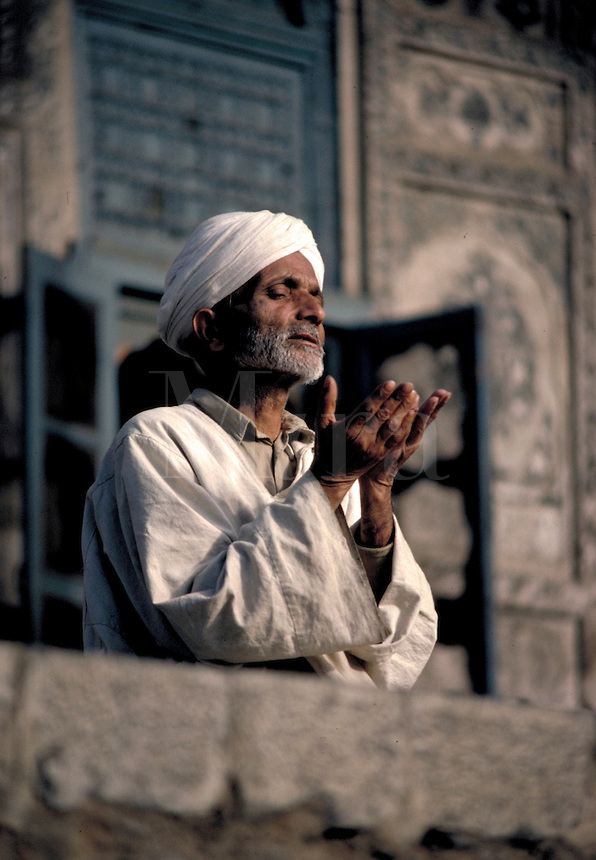 kht-i-Sulaiman (Throne of Solomon), after a local holy man ho, like Francis of Assisi conversed with animals and birds, it was originally built Jaluka (son of Ashoka) round 200 BC, and added to by an anonymous Hindu devotee during the tolerant reign of Jahangir. It makes a fine early-morning climb offering marvellous views of the town, the valleys and the mountains (0.5 km: 1/3 mile I om Srinagar, 1-hour ascent. The hill path commences off Boulevard Road, opposite Nehru Park.)
kht-i-Sulaiman (Throne of Solomon), after a local holy man ho, like Francis of Assisi conversed with animals and birds, it was originally built Jaluka (son of Ashoka) round 200 BC, and added to by an anonymous Hindu devotee during the tolerant reign of Jahangir. It makes a fine early-morning climb offering marvellous views of the town, the valleys and the mountains (0.5 km: 1/3 mile I om Srinagar, 1-hour ascent. The hill path commences off Boulevard Road, opposite Nehru Park.)
Coming alongside the fort, by the jail, turn right, then sharp left, to proceed down tie long Gurudwara Naidyat Road. This brings you out on the western bank of the 1)al Lake, and (after 5 mins by cycle along the lakeside to Hazratbal Mosque, 7 km 1/2 miles) from town. This elegant white-marble shrine—with its perfectly propor- I single-domed façade and single accompanying minaret has been compared I the Taj Mahal. The cone-shaped dome (not round, as in Mughal structures) and verlapping terraces define it, however, as a typical example of Kashmiri architectare. Its particular importance lies in the single hair of the Prophet Mohammed anshrined here. The original mosque on this site dates back some 600 years; the new 1 building was created from voluntary subscriptions very recently.
The best time to aisit is Friday, for 1.30 pm prayers. There are hordes of people, and an amazing bazaar aomplete with grizzled mountain men sucking hookahs, women in black purdah haggling expertly over meat and bread, vast cauldrons bubbling with bright-red holy f ood, and street dentists and opticians fitting old dentures and specs onto hopeful passers-by; and lots of dust, smoke and noise. The market closes at 4 pm.

